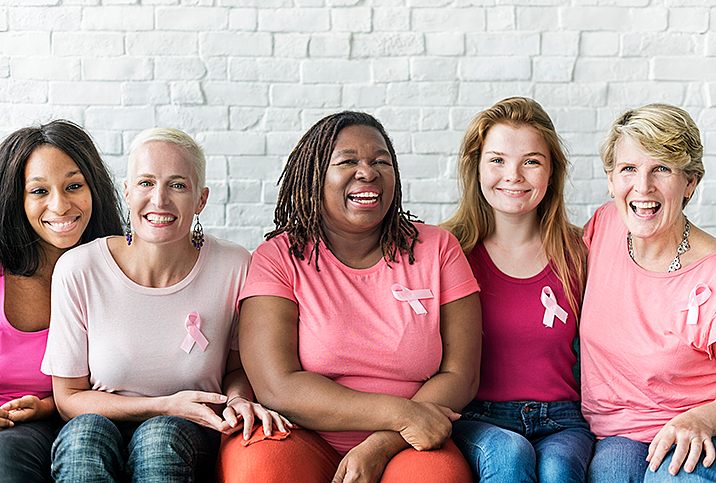Risk Factors for Breast Cancer

Breast cancer is the second most common cancer diagnosis in women. A woman's risk for developing it varies widely and depends on many factors, some of which can’t be controlled and others that can, offering an opportunity to make changes that can lessen the chances of developing the disease.
An overview of breast cancer
Breast cancer refers to the abnormal growth of cells originating in the breast tissue. It manifests in a number of ways, but the signs and symptoms are often similar, including a change in size, shape, texture or symmetry of a breast; changes in breast skin, including dimpling, puckering, peeling, scaling, crusting, flaking and redness; nipple inversion and bloody or watery nipple discharge. These noticeable changes or detecting a mass during a manual self-exam, a clinician exam or a routine mammogram may prompt additional screening, such as an ultrasound, MRI or biopsy. Treatments range from surgery, chemotherapy and radiation to hormonal therapy, targeted therapy and immunotherapy to palliative care.
Advances in screening, detection and treatment have dramatically improved outcomes in the United States, but breast cancer still represents 30 percent of new cancer cases in American women and is the number-two cancer-related killer of them after lung cancer.
Demographics
While breast cancer affects both sexes, it is more than 100 times more common in women than in men. About 13 percent of women—that's 1 in 8—will be diagnosed with breast cancer in their lifetime. Along with being female, age is one of the greatest risk factors: 80 percent of women diagnosed are age 45 or older, and the risk increases significantly after age 55.
Under age 45, Black and Ashkenazi Jewish women are more frequently affected than white women. Women with a first-degree relative (mother, sister or daughter) who has had breast cancer are twice as likely to be diagnosed. Also at increased risk are women who:
-
Have dense breasts
-
Started menstruating before age 12 or started menopause after 55
-
Have a personal history of breast cancer or certain breast diseases
-
Have had previous radiation treatment
-
Have been exposed to the miscarriage-prevention drug diethylstilbestrol (DES)
Genetic risk factors
Researchers have now identified 110 genes linked to breast cancer. An estimated 5 to 10 percent of breast cancer diagnoses are related to an inherited gene mutation, such as with the BRCA1 and BRCA2 gene, which have as much as a 72 and 69 percent lifetime risk of breast cancer, respectively. These genes, when healthy, help repair damaged DNA in normal cells, but the mutated genes can cause abnormal cell growth and cancer, and they increase the likelihood of being diagnosed at a younger age and of developing cancer in both breasts. Other inherited gene mutations linked to breast cancer include ATM, TP53, CHEK2, PTEN, CDH1, STK11, PALB2 and BRIP1.
That said, about 85 percent of women diagnosed have no family history. Their cancer is the result of genetic mutations that occurred throughout their lifetime, due to aging, lifestyle and/or environmental exposures.
Environmental risk factors
Chemicals in plastics, such as endocrine-disrupting bisphenol A (BPA) and bisphenol S (BPS), have been linked to cancer development. Research presented at the Endocrine Society’s ENDO 2017 meeting reported BPS (the supposedly safer alternative to BPA) similarly mimics estrogen in the body and may increase the aggressiveness of breast cancer cells, as well as increase the risk of developing cancer in women already predisposed with mutation genes such as BRCA1.
While breast cancer affects both sexes, it is more than 100 times more common in women than in men.
Chemicals in cosmetics, foods, lawns, gardens and even the water supply all may play a role. A 2019 study by the Environmental Working Group linked 100,000 cancer cases to carcinogens—arsenic, radioactive materials and disinfectant byproducts—in drinking water. Food preparation is a factor: Cooking meat over high temperature releases polycyclic aromatic hydrocarbons and heterocyclic amines (HCAs), which can alter DNA and increase cancer risk. In a study published in 2017, The Journal of the National Cancer Institute found that of women diagnosed with breast cancer, those who consumed high amounts of grilled, barbecued or smoked meats had a 23 percent greater risk of both all-cause and breast cancer–related mortality compared with women who consumed low amounts.
Behavioral risk factors
Physical inactivity, being overweight, taking combined hormone replacement therapy (HRT) after menopause and certain oral contraceptives, not having a full-term pregnancy before age 30, not breastfeeding and consuming alcohol all increase your risk for developing breast cancer.
A 2013 study in the Journal of Cancer Prevention reported that a sedentary lifestyle can increase breast cancer risk through multiple mechanisms, including weakening the immune system, increasing insulin resistance and causing inflammation. Some studies indicate poor diet is the cause of 30 to 40 percent of cancers. Low levels of vitamin D may also play a role, as it may stop cancerous cells from growing. A small study of 180 women published in The Indian Journal of Endocrinology and Metabolism in 2012 found low vitamin D in 95.6 percent of breast cancer patients compared to 77 percent of the control group. Smoking and even working night shifts, which can alter hormone levels, may also play a role. A 2017 study published in Breast Cancer Research indicated that, compared to women who had never smoked, those who had experienced a 14 percent increase in breast cancer risk; a 24 percent increase was seen in those who had smoked before age 17.
Genetic testing
Women with a family history of the BRCA1 or BRCA2 gene mutation may be recommended for genetic testing to determine if they have inherited the mutation, which can inform screening recommendations and other preventive measures for higher-risk women. A 2020 study from the journal Cancers reported breast cancer recurrence or distant metastasis was significantly more likely and survival significantly less likely in women who delayed testing (more than one year). Testing can also be helpful after a positive diagnosis, as the involvement of certain genes provides information about the likelihood of extent and the speed of spread, which can dictate treatment. Other genes less commonly linked to breast cancer may certainly also be tested for.
Genetic testing has its pros and cons and is not recommended for all women. Talking with a doctor or a genetic counselor can provide a better sense of your risk, and they can explain what the test can and cannot determine. Tests can be inconclusive or show positive results for a gene variant for which associated risk is currently unknown. This can be frustrating or leave you feeling alarmed about or unsure of what to do with such information. That said, testing has helped protect countless women. Consult your doctor before pursuing any direct-to-consumer genetic tests, because they can be difficult to interpret and result in misinterpretation of personal risk.
Prevention
For the most part, behavioral risk factors are considered modifiable—meaning lifestyle changes can have a positive impact. Opting not to smoke, reducing alcohol consumption, eating a balanced diet, prioritizing exercise and activity, maintaining a healthy weight and minimizing exposure to HRT and certain oral contraceptives can significantly reduce behavioral risk factors, as well as the overall risk for breast cancer.
Breast cancer can affect anyone, but you can improve your chances of staying healthy by understanding risk factors and minimizing those over which you have control.
Minimize exposure to processed foods, choose organic produce and reduce meat consumption or cook it through safer methods: boiling, poaching, steaming, stewing. Research indicates a primarily plant-based, whole-foods diet high in vegetables, fruits and whole grains, and with minimal salt and sugar, can significantly reduce cancer risk. In 2013, results from a 20-year study funded by the Women’s Health Initiative found women who consumed a plant-based diet were 20 percent less likely to die of breast cancer. Benefits were even greater for high-risk individuals: Among women with three metabolic risk factors (obesity, diabetes, high blood pressure), those who followed a low-fat, plant-based diet were 69 percent less likely to die of breast cancer than those who didn’t. Incorporating vitamin D-rich foods—fortified cereals, milk and juices, mushrooms, spinach, soybeans and oily fish—into your diet is beneficial, as is spending 20 minutes in the sunlight (with sunscreen).
Use glass or other BPA-free containers for water, drinks and food storage. Avoid lawn and garden pesticide sprays; if you do use them, limit time spent outdoors immediately after treatment. Research the ingredients in your cosmetic products, including sunscreen. Have your tap water tested if you use a private or community well, and consider filters and reverse osmosis systems for tap water. New mothers should breastfeed, if possible, ideally for more than a year. Doing so can reduce breast cancer risk: Breastfeeding delays a woman's menstruation, reducing her exposure to certain hormones, especially estrogen, which is known to promote the growth of breast cancer cells.
Research shows that exercising for four to seven hours a week at a moderate to intense level reduces breast cancer risk, and a 2003 study by the Women’s Health Initiative reported 75 to 150 minutes of brisk walking a week could reduce breast cancer risk by 18 percent. (Exercise reduces estrogen levels, boosts the immune system and supports a healthy weight.)
Breast cancer can affect anyone, but you can improve your chances of staying healthy by understanding risk factors and minimizing those over which you have control. Being proactive can help save your life.


















